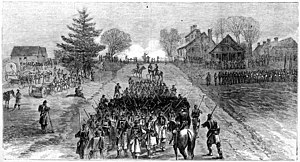Mine Run Campaign
| Battle of Mine Run | |||||||
|---|---|---|---|---|---|---|---|
| Part of the American Civil War | |||||||
 Artillery bombardment with Warren's troops awaiting attack (from Harper's Weekly) |
|||||||
|
|||||||
| Belligerents | |||||||
|
|
|
||||||
| Commanders and leaders | |||||||
| George G. Meade | Robert E. Lee | ||||||
| Units involved | |||||||
| Army of the Potomac | Army of Northern Virginia | ||||||
| Strength | |||||||
| 81,000 | 48,000 | ||||||
| Casualties and losses | |||||||
| 1,272 | 680 | ||||||
The Battle of Mine Run, also known as Payne's Farm, or New Hope Church, or the Mine Run Campaign (November 27 – December 2, 1863), was conducted in Orange County, Virginia, in the American Civil War.
An unsuccessful attempt of the Union Army of the Potomac to defeat the Confederate Army of Northern Virginia, it was marked by false starts and low casualties and ended hostilities in the Eastern Theater for the year.
After the Battle of Gettysburg in July, Confederate Gen. Robert E. Lee and his command retreated back across the Potomac River into Virginia. Union commander Maj. Gen. George G. Meade was widely criticized for failing to pursue aggressively and defeat Lee's army. Meade planned new offensives in Virginia for the fall. His first attempt was a series of inconclusive duels and maneuvers in October and November known as the Bristoe Campaign.
In late November, Meade attempted to steal a march through the Wilderness of Spotsylvania and strike the right flank of the Confederate Army south of the Rapidan River. Meade had intelligence reports that Lee's army, half the size of Meade's Army of the Potomac (actually 48,000 to Meade's 81,000), was split in two, separated by Clark's Mountain, with the two flanks anchored at Mine Run and Liberty Mills, over thirty miles apart. His plan was to cross the Rapidan at points beyond Maj. Gen. J.E.B. Stuart's cavalry screen, overwhelm the right flank (Lt. Gen. Richard S. Ewell's Second Corps) and then follow up with the remainder (Lt. Gen. A.P. Hill's Third Corps).
...
Wikipedia
